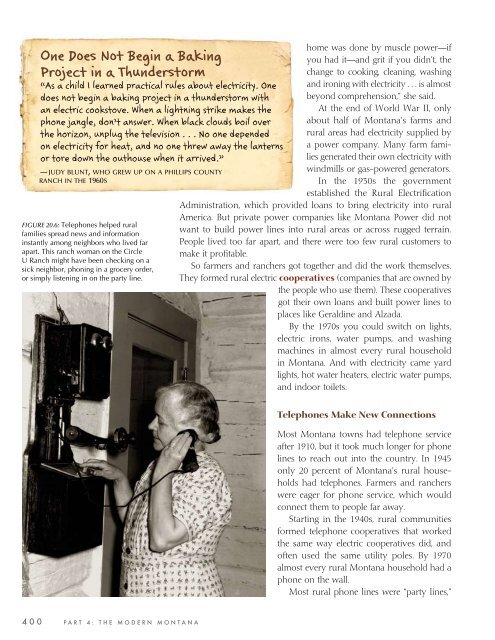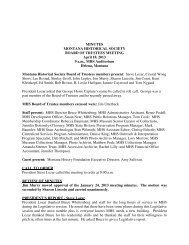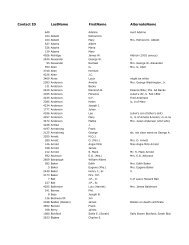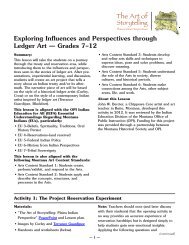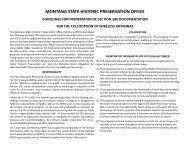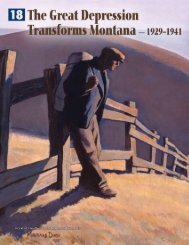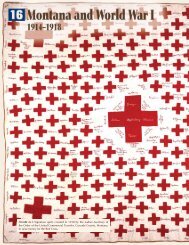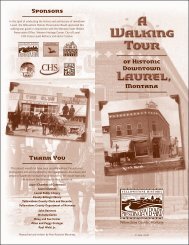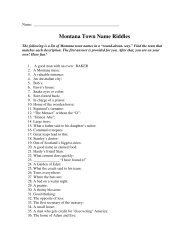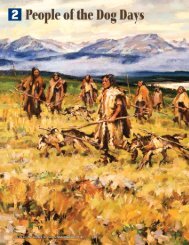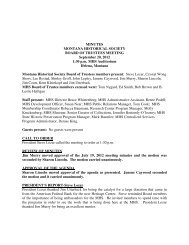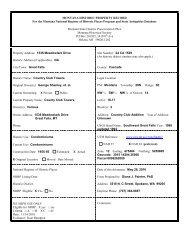Chapter 20 - Montana Historical Society
Chapter 20 - Montana Historical Society
Chapter 20 - Montana Historical Society
You also want an ePaper? Increase the reach of your titles
YUMPU automatically turns print PDFs into web optimized ePapers that Google loves.
One Does Not Begin a Baking<br />
Project in a Thunderstorm<br />
“As a child I learned practical rules about electricity. One<br />
does not begin a baking project in a thunderstorm with<br />
an electric cookstove. When a lightning strike makes the<br />
phone jangle, don’t answer. When black clouds boil over<br />
the horizon, unplug the television . . . No one depended<br />
on electricity for heat, and no one threw away the lanterns<br />
or tore down the outhouse when it arrived.”<br />
—JUDY BLUNT, WHO GREW UP ON A PHILLIPS COUNTY<br />
RANCH IN THE 1960S<br />
FIGURE <strong>20</strong>.6: Telephones helped rural<br />
families spread news and information<br />
instantly among neighbors who lived far<br />
apart. This ranch woman on the Circle<br />
U Ranch might have been checking on a<br />
sick neighbor, phoning in a grocery order,<br />
or simply listening in on the party line.<br />
4 0 0 P A R T 4 : T H E M O D E R N M O N T A N A<br />
home was done by muscle power—if<br />
you had it—and grit if you didn’t, the<br />
change to cooking, cleaning, washing<br />
and ironing with electricity . . . is almost<br />
beyond comprehension,” she said.<br />
At the end of World War II, only<br />
about half of <strong>Montana</strong>’s farms and<br />
rural areas had electricity supplied by<br />
a power company. Many farm families<br />
generated their own electricity with<br />
windmills or gas-powered generators.<br />
In the 1930s the government<br />
established the Rural Electrifi cation<br />
Administration, which provided loans to bring electricity into rural<br />
America. But private power companies like <strong>Montana</strong> Power did not<br />
want to build power lines into rural areas or across rugged terrain.<br />
People lived too far apart, and there were too few rural customers to<br />
make it profi table.<br />
So farmers and ranchers got together and did the work themselves.<br />
They formed rural electric cooperatives (companies that are owned by<br />
the people who use them). These cooperatives<br />
got their own loans and built power lines to<br />
places like Geraldine and Alzada.<br />
By the 1970s you could switch on lights,<br />
electric irons, water pumps, and washing<br />
machines in almost every rural household<br />
in <strong>Montana</strong>. And with electricity came yard<br />
lights, hot water heaters, electric water pumps,<br />
and indoor toilets.<br />
Telephones Make New Connections<br />
Most <strong>Montana</strong> towns had telephone service<br />
after 1910, but it took much longer for phone<br />
lines to reach out into the country. In 1945<br />
only <strong>20</strong> percent of <strong>Montana</strong>’s rural households<br />
had telephones. Farmers and ranchers<br />
were eager for phone service, which would<br />
connect them to people far away.<br />
Starting in the 1940s, rural communities<br />
formed telephone cooperatives that worked<br />
the same way electric cooperatives did, and<br />
often used the same utility poles. By 1970<br />
almost every rural <strong>Montana</strong> household had a<br />
phone on the wall.<br />
Most rural phone lines were “party lines,”


